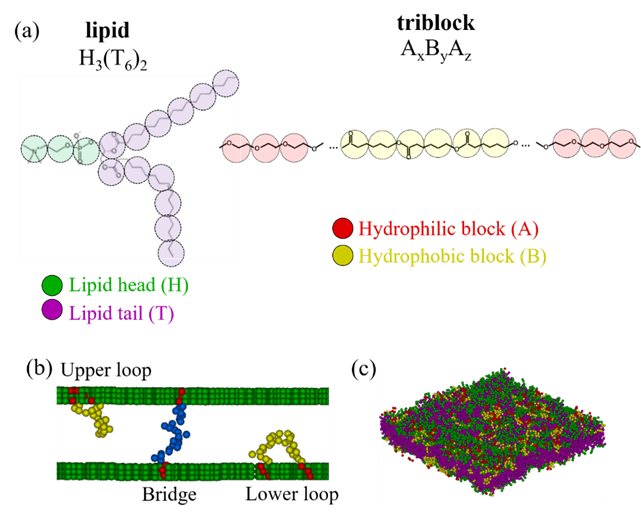The vesicle formed by a membrane enclosing an aqueous solution can be used as drug delivery systems or biosensors, and therefore they have attracted great attention of many researches in the biological and pharmaceutical fields. Hybrid membranes of lipids and AxByAz triblock copolymers (Fig. 1a) can possess better biocompatibility and mechanical stability. In this work, copolymer conformations and stability of asymmetric membranes are explored by dissipative particle dynamics. The copolymers in the membranes exhibit either the bridge or loop conformation as shown in Fig. 1b. As hydrophobic B-blocks interact attractively with lipid heads, bridge-shaped copolymers are significantly inhibited and loop-shaped copolymers prefer to stay at the interface between hydrophilic and hydrophobic layers. This floating loop has a flattened conformation, consistent with the experimental findings (Fig. 2). In contrast, for repulsive interactions between B-blocks and lipid heads, bridge-shaped copolymers are abundant and loop-shaped copolymers tend to plunge into the hydrophobic layer. This diving loop displays a random coil conformation. The asymmetric membrane in which the fractions of loop-shaped copolymers in the upper and lower leaflets are different is thermodynamically unstable. Two approaches are proposed to acquire kinetically stable asymmetric membranes. First, membrane symmetrization is arrested by eliminating bridge-shaped copolymers, which is achieved by B-block/lipid head attraction and B-block/lipid tail repulsion (Fig.3). Second, asymmetric triblock copolymers (x≠z) are used to prevent the passage of the long A-block through the hydrophobic layer (Fig.3). (化工系諶玉真教授提供)

Figure 1. (a) Schematic representations of the coarse-grained lipid and triblock copolymer models used in DPD simulations. (b) Three types of polymer conformations, including upper loop, bridge, and lower loop from left to right, respectively. (c) The snapshot of an equilibrium planar hybrid membrane with zero tension.

Figure 2. As hydrophobic B-blocks interact attractively with lipid heads, bridge-shaped copolymers are significantly inhibited and loop-shaped copolymers prefer to stay at the interface between hydrophilic and hydrophobic layers.

Figure 3. The representative snapshots of morphological transformation associated with spontaneous asymmetrization for asymmetric triblock copolymers (x≠z). Bridge-shape copolymers are specifically marked in blue.